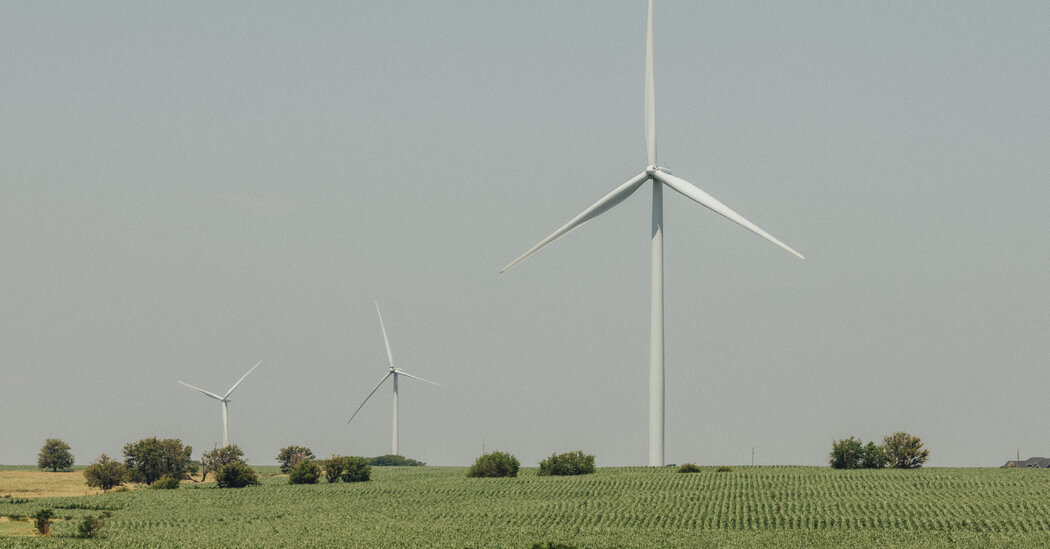First came President Trump’s freezing of federal support for many renewable energy projects, coupled with cries of “drill, baby, drill.”
Then came the tariffs.
The president’s trade war is expected to drive up the costs of nearly every component of clean-energy production in the United States, from the steel in wind turbines to the batteries in electric vehicles.
Many of those building blocks are imported from the European Union, China and Southeast Asia, where some of the highest tariff rates were assigned.
How that affects the energy mix inside the United States is complicated, experts say. After all, rising costs for these and other materials won’t affect only renewable energy. Many of Mr. Trump’s trade policies, including tariffs on steel and aluminum, will also hit fossil fuels, making it more expensive to build natural-gas export terminals and drill oil wells, despite the president’s pledge to make oil and gas cheaper and more plentiful.
Yet the renewable energy industry is bracing for particularly large effects.
Vanessa Sciarra, vice president of trade and international competitiveness for the American Clean Power Association, a renewable energy trade group, said that “policy whiplash” was endangering Americans’ access to affordable and reliable energy by severing supply chains.
The tariffs are widely expected to reorder the energy landscape far beyond U.S. borders, too.
U.S. oil and gas exports have surged over the past decade, but longer-term prospects for growth abroad were already shaky, with buyers in Europe and Asia trying to reduce their reliance on fossil fuels as part of their pledges to cut emissions of planet-warning greenhouse gases. The possibility that China or the European Union could impose retaliatory tariffs on American fossil fuels might put a further dent in those exports, analysts said.
Globally, a huge shift toward using renewable energy in electricity production is already underway, largely thanks to China’s growing ability to produce cheap, high-quality solar panels, wind turbines and lithium-ion batteries on an enormous scale. The United States imports many of its solar-panel components from Chinese companies operating in Southeast Asian countries. And the majority of lithium-ion batteries that the United States imports for use in power grids and electric vehicles come from China itself.
Some analysts pointed to India as a relative beneficiary of the shifting landscape. India is currently ramping up its own domestic solar and battery manufacturing, and was hit with lower tariff rates than China or some countries in Southeast Asia that are major clean-tech producers, said Antoine Vagneur-Jones, head of trade and supply chains at BloombergNEF.
China is also likely to redirect more of its exports toward emerging markets like Pakistan or Brazil. The share of Chinese exports of wind turbines, solar panels and electric vehicles that go to low- or middle-income countries, as opposed to the United States or Europe, has grown sharply the past three years.
In 2022, for instance, China sent roughly 65 percent of its wind turbine exports to high-income countries, according to BloombergNEF. By 2024, however, it was sending more than 60 percent to low- and middle-income countries. Beijing has laid out plans to build factories that assemble solar panels in Nigeria and electric vehicles in Indonesia.
“Unless they want to burn money, I don’t see why any Chinese clean-tech companies would further invest in the American market,” said Li Shuo, the director of China Climate Hub at the Asia Society Policy Institute. “I wonder if this moment marks the effective conclusion of the Biden energy transition strategy, which was the attempt to create a domestic green energy industry that could compete with China’s.”
In recent years, many solar, wind and battery manufacturers had sought to open new factories in the United States, spurred by generous tax credits and incentives from the 2022 Inflation Reduction Act. The United States now has the capacity to make 50 gigawatts’ worth of solar modules, enough to satisfy U.S. demand, although it still imports many of the underlying components such as cells and wafers.
This year, wind, solar and batteries are projected to make up 93 percent of new electric capacity added to American grids. In many places, building new wind turbines or installing solar panels are often the cheapest ways to generate additional electrons.
In theory, tariffs could spur more domestic clean energy manufacturing in the United States. But further uncertainty over whether Republicans in Congress might repeal some or all of the Inflation Reduction Act, and pare back incentives for electric vehicles or domestic manufacturing, has already caused companies to pause new investments or cancel planned factories.
Because the tariffs are so broad-based, moving renewable energy production to the United States seemed unlikely even in the long term, said Coco Zhang, vice president of sustainability investing at the financial services firm ING, particularly with the Trump administration’s freezing of federal investments in renewable energy. Manufacturers would need to make risky investments in relocating their entire supply chains — steel-making, mineral processing, assembly lines — to make it cost-effective.


